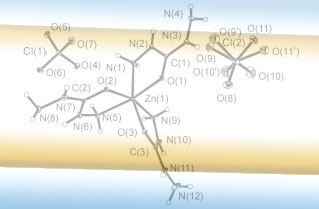化学学报 ›› 2011, Vol. 69 ›› Issue (08): 987-992. 上一篇 下一篇
研究论文
齐书元,李志敏,张同来*,周遵宁,杨利,张建国,乔小晶,郁开北
QI Shu-Yuan, LI Zhi-Min, ZHANG Tong-Lai, ZHOU Zun-Ning, YANG Li, ZHANG Jian-Guo, QIAO Xiao-Jing, YU Kai-Bei

通过碳酰肼水溶液与高氯酸锌水溶液反应制得含能配合物[Zn(CHZ)3](ClO4)2. 培养获得了配合物的单晶, 用X射线单晶衍射法测定了晶体结构, 该晶体属于单斜晶系、P2(1)/n空间群, 晶胞参数a=1.0005(2) nm, b=0.8428(1) nm, c=2.1218(4) nm, β=100.948(3)°, V=1.7566(5) nm3, Dc=2.021 g/cm3, Z=4, F(000)=1088, R1=0.0341, ωR2=0.0729. 该配合物分子式为[Zn(CHZ)3](ClO4)2, CHZ分子配体通过羰基O原子和端位N原子与锌离子形成配位键, 构成稳定的五元环结构. 差示扫描量热(DSC)分析和热重-微分热重(TG-DTG)分析结果表明, [Zn(CHZ)3](ClO4)2在270 ℃以下无分解反应, 耐热性好|在280~340 ℃之间发生剧烈的连续放热分解, 具有起爆药的热分解特征. 感度性能测试结果表明, Zn(CHZ)3](ClO4)2对撞击、摩擦、火焰等外界刺激不敏感, 安全性好.